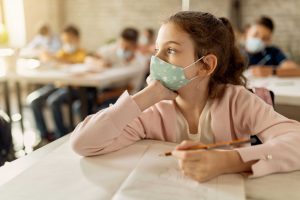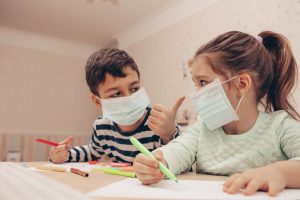With a final check on the morning’s assignment board, I turn my attention to the most important task of my day: greeting my students. This task sets the tone for the day. Not only do I greet my own students, but I always share my smile and words of encouragement to many others in the hallways. In the early morning, I see a lot of tired faces. It is like a super power to be able to change tired to happy. You see, a school is not a school without the students. They are the reason that we are all here.
 I stand outside the classroom door and begin to see the students filter down the hallway. They come a few at a time.
I stand outside the classroom door and begin to see the students filter down the hallway. They come a few at a time.
This is when I am reminded that my smile power doesn’t work like it used to.
I am greeted by their eyes without faces just as they are greeted by my eyes without a face. We have all become enigmas to one other. There is a disconnect between us all, a hampering of humanity caused by a thin piece of fabric. We are eyes without faces.
Once in the classroom, the students are eager to say their hellos to each other and unpack. They are happy to be with each other, and the noise level is proof. This camaraderie is the glue in their developing social world. Through masked faces, the children struggle to make connections with muffled voices and hand gestures. Many will often drop their masks to show their faces, their smiles. My voice cuts through their conversations reminding them to raise their masks, to hide their smiles. Instead of fostering our classroom community, I am inhibiting it with sterile reminders to cover their faces. My reminders pierce into their happiness at being together. As I chastise them for lowering their masks, my stomach is in a knot. Instead of being a nurturing motivator, a distance has forged itself between my students and myself each time I remind them about their masks. That thin fabric has wedged itself into place as a barrier. Though their efforts are ardent in trying to socialize with each other, they comply and settle in their seats.
 As we transition to the first lesson, the children focus their attention on our work. I look toward them, and what I see are their eyes peering out above their masks: cloth masks, colored masks, patterned masks, black masks, medical blue masks, masks with cartoon characters on them. I find it most ironic that the forever smiles on the characters are the smiles I teach instead of those of my students. Students who wear glasses are a further mystery. Each moment reminds me of how important their facial feedback is to me as I teach as well as mine as I try to convey concepts and encourage their efforts.
As we transition to the first lesson, the children focus their attention on our work. I look toward them, and what I see are their eyes peering out above their masks: cloth masks, colored masks, patterned masks, black masks, medical blue masks, masks with cartoon characters on them. I find it most ironic that the forever smiles on the characters are the smiles I teach instead of those of my students. Students who wear glasses are a further mystery. Each moment reminds me of how important their facial feedback is to me as I teach as well as mine as I try to convey concepts and encourage their efforts.
When soliciting participation, I often must ask my students to repeat what they said but louder. Sometimes, a student needs two or three attempts before they are understood. The lesson drags on as the repetition attempts continue. In some cases, the students move their masks down themselves as they speak. I think about how often they are touching their masks each day with their hands. Each touch compromises the cleanliness of the fabric in front of their noses.
Achoo! A student sneezes into her mask. I now ask her to go get another one from the nurse. Sometimes, they say no and continue wearing it. Throughout the lesson, I work extra hard to use my voice and hands to teach. My facial features have been silenced behind fabric. This is something that I have not gotten used to after these two years. I feel as if something is missing, because it is.
As the day goes on, the students begin to lose steam. There are students who ask for mask breaks, those that get antsy in their seats, and sometimes students who tell me that they have a headache. Eating their snack is an oasis of normality; I can see their faces. This is the moment that I catch a glimpse of a dimple, of the shapes of their noses, and of the way that they sound without being muffled by fabric. This is also the time when sociability feels good and smiles are commonplace. I am happy to see the children just be children who laugh and joke around with their friends. This bit of normality feels refreshing.
Soon enough, our day comes to a close. There is a bustle of energy as backpacks are stuffed with books and lunchboxes. By this time, there is a very tired group of children who are eager to go home. The children have put in seven hours of mask wearing by now. Sometimes I catch glimpses of ears being rubbed from having to wear their masks. I notice that many masks are worn under their noses by now. Saying their goodbyes is another time when the children instinctively pull down their masks. They want to impart a smile or two to match a joke or show their excitement at a funny story from a friend. Their camaraderie is the glue that holds our bonds together. They are all the unique and special people that make up our classroom family under their masks.
As the students leave the room, they dash for the buses and I am left in the quiet stillness of the classroom. Alone now, I take off my own mask. The first thing I do is inhale a clean breath. As I exhale, I drop my shoulders and release a bit of the energy from the day. It feels so good to have my own face fresh to the world. Without my mask on, I always notice how much lighter my face feels once it can be free. The clean air feels rejuvenating on my skin. I wonder when my students will be able to also feel this free. Are they on the school bus and must still keep their mask on? Are they able to be fresh-faced to the world?
Even after these two years, I myself have not gotten used to wearing a mask. It has completely inhibited my ability to be the caliber of teacher that I normally am. Every day I wonder what kind of day the children had with me at school. Were they able to have an enriching day? Did they go home happy and fulfilled? Were they able to express who they were today and celebrate their individuality? It always strikes me at how compliant the children are in wearing the masks. This in itself is a powerful reminder of just how impressionable they are to the rules placed on them.
 I could go on about the effectiveness of mask wearing, the issue for special needs students, speech and language considerations and how these standards have recently been lowered, how even the CDC’s own guidelines show that 99.997% of children have survival rates for Covid-19, and how most children will tell you that they do not like wearing the masks, but this issue has become quite polarized. We hold a sacred duty to protect our children and foster their development into successful adults. Is masking our children worth it?
I could go on about the effectiveness of mask wearing, the issue for special needs students, speech and language considerations and how these standards have recently been lowered, how even the CDC’s own guidelines show that 99.997% of children have survival rates for Covid-19, and how most children will tell you that they do not like wearing the masks, but this issue has become quite polarized. We hold a sacred duty to protect our children and foster their development into successful adults. Is masking our children worth it?
“Children are not people to be molded, but people to be unfolded.” –Jess Lair
The Warwick Watch is distinguishing itself as a new medium in getting information and opinion out into the public square. Please submit any information or opinion to us. Your identity will be protected. -thewarwickwatch@gmail.com
